From the bustling streets of Hanoi to the tranquil waterways of the Mekong Delta, each region boasts its unique noodle dish, reflecting its own history and influences. While some are steeped in centuries of tradition, others have evolved, embracing new ingredients and techniques. This article will take you on a gastronomic journey through the length and breadth of Vietnam, unveiling five iconic Vietnamese noodles varieties, each telling its own delicious tale.
Top 5 Iconic Vietnamese noodle
1/Phở: Vietnam’s Global Ambassador
Few dishes can claim to represent a country as thoroughly as Phở does for Vietnam. Recognized globally, this Vietnamese noodle soup is not just a meal, but an experience that captivates all senses.
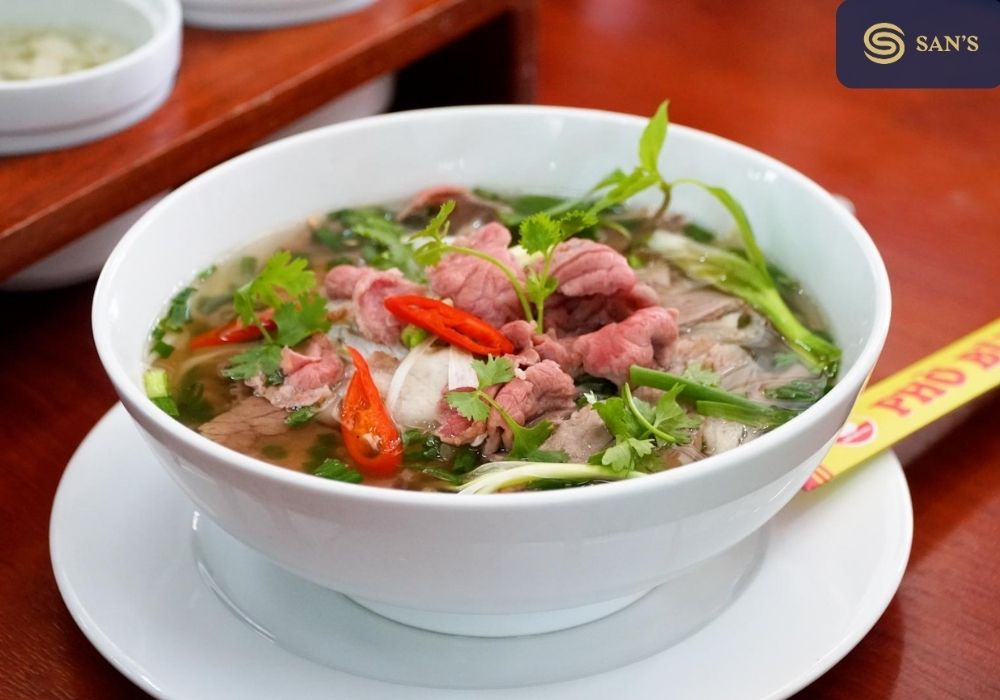
- Origins and history:
Phở’s roots trace back to the northern parts of Vietnam, near Hanoi, in the early 20th century. Influenced possibly by both Chinese and French cooking, this simple, yet richly flavored dish, started its journey from humble street stalls in Nam Dinh province and soon spread its aroma throughout the country. Over time, as people migrated, Phở traveled with them, evolving in flavor and gaining popularity, not just within Vietnam but across oceans. - Differences between Phở Bò (beef) and Phở Gà (chicken):
While both varieties offer a delectable taste experience, they have distinct characteristics. Phở Bò is all about the depth and richness of its beef bone broth, often simmered for hours, complemented by thin slices of beef, which can range from tender brisket to chewy tendon. On the other hand, Phở Gà offers a lighter, clearer broth with the subtle flavors of chicken, complemented by shredded chicken meat. The choice of herbs, garnishes, and even noodles can vary slightly between the two, catering to the specific protein. - Regional variations: Northern vs. Southern Phở:
As with many Vietnamese dishes, Phở too has its regional dialects. The Northern version, especially around Hanoi, stays true to its origins – it’s all about simplicity. The broth is clear and subtly seasoned, letting the quality of the beef or chicken shine through. Garnishes are minimal, often just including green onions and coriander. In contrast, Southern Phở, particularly in Ho Chi Minh City, embraces extravagance. The broth is sweeter and more robust in flavor. It’s served with a plethora of herbs, sprouts, lime wedges, and chili sauces, allowing diners to customize their bowl to their liking.
2/Bún Riêu: The Vietnamese Noodle Delight with a Seafood Twist
Bún Riêu is a testament to the complexity and nuance present in Vietnamese cuisine. At the heart of this delightful dish is the interplay between the tangy tomato broth and the richness of crab and shrimp, making it a standout in the expansive world of Vietnamese noodles.
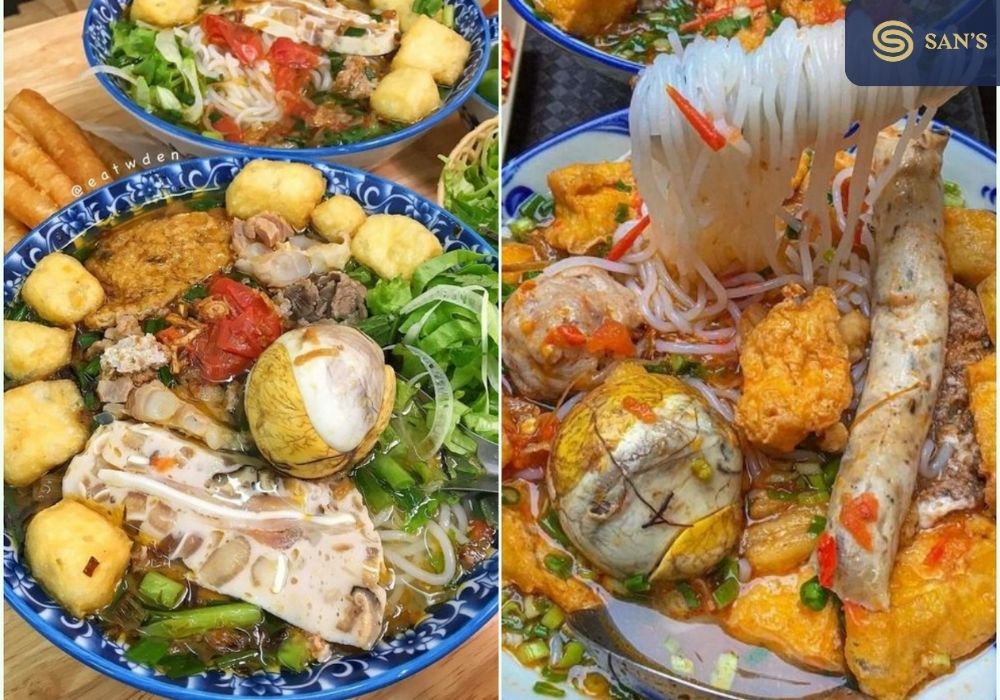
- Introduction to this tomato-based soup with crab and shrimp:
Venturing into the realm of Vietnamese noodle dishes, Bún Riêu is a vibrant soup that draws its unique flavor from freshwater crab paste and shrimp. The bright red hue of the broth, thanks to the tomatoes, not only lends it an appealing visual but also a tangy taste that contrasts beautifully with the seafood’s sweetness. - Popular additions and regional twists:
True to the nature of Vietnamese noodle dishes, Bún Riêu is adaptable, and various regions introduce their unique spin to it. While the foundational ingredients remain consistent, in some areas you might find tofu, snails, or even fried shallots adorning your bowl. Fresh herbs, bean sprouts, lime wedges, and banana blossoms are often served on the side, allowing diners to customize their bowl according to their preferences. - The cultural significance and occasions for enjoying Bún Riêu:
Bún Riêu holds a special place in Vietnamese culture. Often enjoyed as a hearty breakfast or a fulfilling lunch, it’s more than just a meal; it’s a reflection of Vietnam’s rich culinary heritage. Street-side vendors, family gatherings, and local eateries, all resonate with the aroma of this Vietnamese noodle soup, making it a cherished dish for both everyday consumption and special occasions.
In the grand tapestry of Vietnamese noodle dishes, Bún Riêu shines not only for its unique flavor profile but also as a symbol of the regional diversity and culinary innovation that Vietnam prides itself on.
3/Bún Thịt Nướng: Vietnamese Noodle Magic with Grilled Mastery
Bún Thịt Nướng captures the essence of Vietnamese culinary artistry, effortlessly blending contrasting temperatures, textures, and flavors. This dish, where cold rice vermicelli meets sizzling grilled meats, is a sensory journey that showcases the multifaceted nature of Vietnamese noodle cuisine.
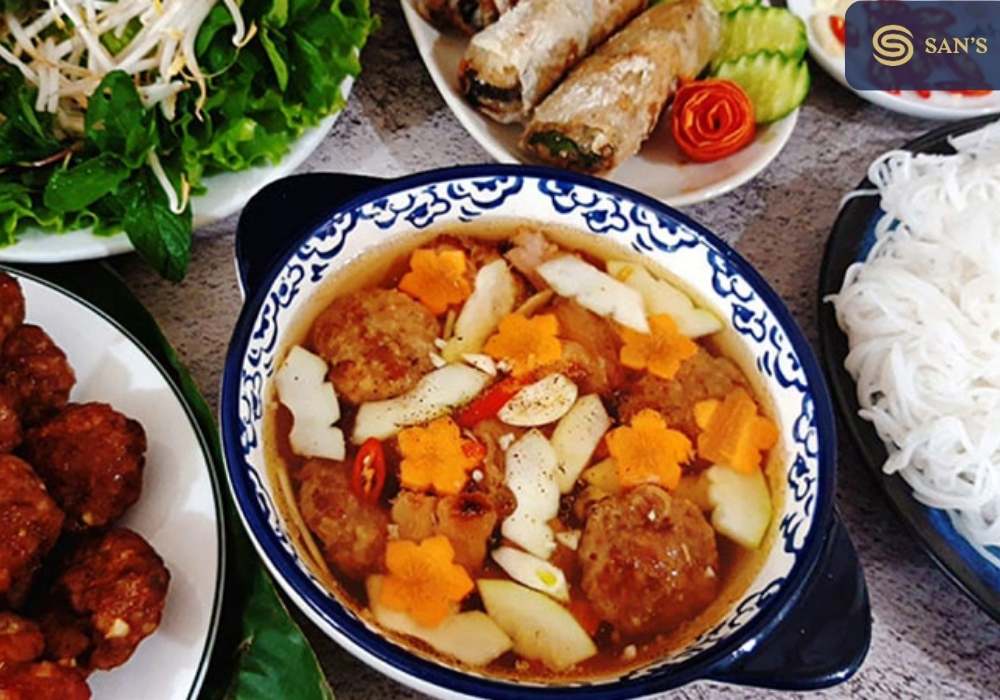
- The allure of grilled meats paired with cold rice vermicelli:
Bún Thịt Nướng introduces diners to a paradoxical yet delightful combination. The cool, soft strands of rice vermicelli lay the foundation, only to be adorned by tantalizing pieces of grilled meat, usually pork, which are marinated to perfection and char-grilled to achieve that unmistakable smoky aroma. The juxtaposition of the cold noodles with the warm, caramelized meat creates a taste experience that’s unparalleled. - Distinguishing toppings and sauces:
While the grilled meat is the star, the ensemble of toppings and sauces adds depth to this Vietnamese noodle dish. Crunchy peanuts, crispy shallots, fresh herbs, and bean sprouts complement the main components. But what truly ties the dish together is the “nước chấm” – a tangy, sweet, and spicy sauce made from fish sauce, garlic, chili, and lime, poured over the dish, ensuring every bite is a burst of flavor. - The balance of flavors and textures that define this dish:
Bún Thịt Nướng is not just a meal; it’s a symphony where each ingredient plays a crucial role. The harmony achieved between the chewy noodles, succulent grilled meats, crispy toppings, and the explosive nước chấm sauce highlights the Vietnamese knack for balancing flavors and textures. Each bite offers sweetness, saltiness, tanginess, and spiciness, all while contrasting softness with crunch.
In the realm of Vietnamese noodle dishes, Bún Thịt Nướng stands tall, offering a culinary experience that engages all the senses and leaves one longing for more. Whether enjoyed on a bustling street corner in Vietnam or a fine dining restaurant abroad, this dish embodies the spirit and flavors of Vietnam in every bowl.
4/Mì Quảng: The Golden Glow of Vietnamese Noodle Heritage from Central Vietnam
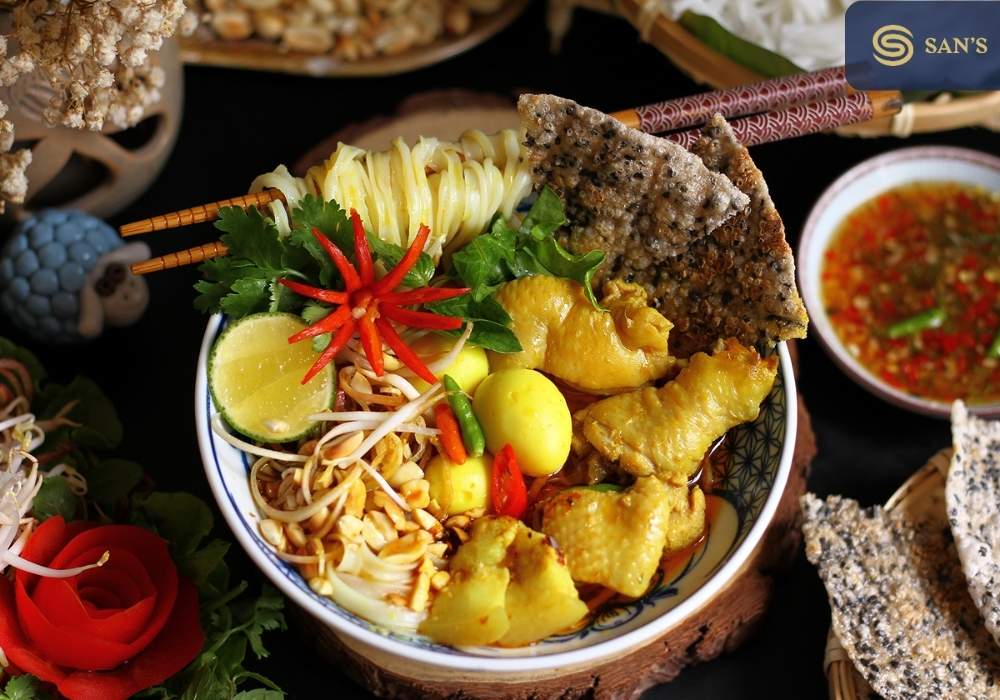
Hailing from the heartland of Central Vietnam, Mì Quảng is more than just a noodle dish; it’s a reflection of the region’s rich history, bountiful produce, and vibrant culture. Its signature turmeric-tinted noodles, combined with a plethora of ingredients, make it a colorful and flavorful representation of the Quảng Nam province.
- The unique characteristics of this turmeric-tinted noodle dish:
What distinguishes Mì Quảng from other Vietnamese noodle dishes is its vibrant yellow noodles, achieved using turmeric. Unlike other noodle soups, the broth in Mì Quảng is served sparingly, just enough to barely cover the noodles. This creates a concentrated burst of flavor with each bite, and the dish is often garnished with a riot of fresh herbs, crushed peanuts, and crispy rice crackers, adding to its distinctive appearance and texture. - Traditional ingredients and preparation methods:
At the heart of Mì Quảng are its wide rice noodles, which serve as a canvas for an array of ingredients. Depending on the variant, it can feature shrimp, pork, chicken, or even fish. The protein is often simmered with seasonings until tender. The broth, usually made from simmering meat and bones, is seasoned with fish sauce, black pepper, shallots, and garlic. The dish is completed with toppings like roasted peanuts, fresh herbs, and toasted sesame rice crackers, which lend a satisfying crunch. All these elements come together in a harmony of flavors and textures, making Mì Quảng a delightful culinary experience. - The cultural roots of Mì Quảng in the Quảng Nam province:
Mì Quảng is deeply embedded in the culture of Quảng Nam, often being the centerpiece at family gatherings, local festivals, and special occasions. Its origin is a testament to the region’s resourcefulness and ingenuity, using local ingredients to craft a dish that’s both hearty and flavorful. Over the years, while the dish has gained popularity across Vietnam and even internationally, for the locals of Quảng Nam, it remains a cherished reminder of home.
5/Bánh Canh: The Thick and Chewy Noodle Delight of Vietnam
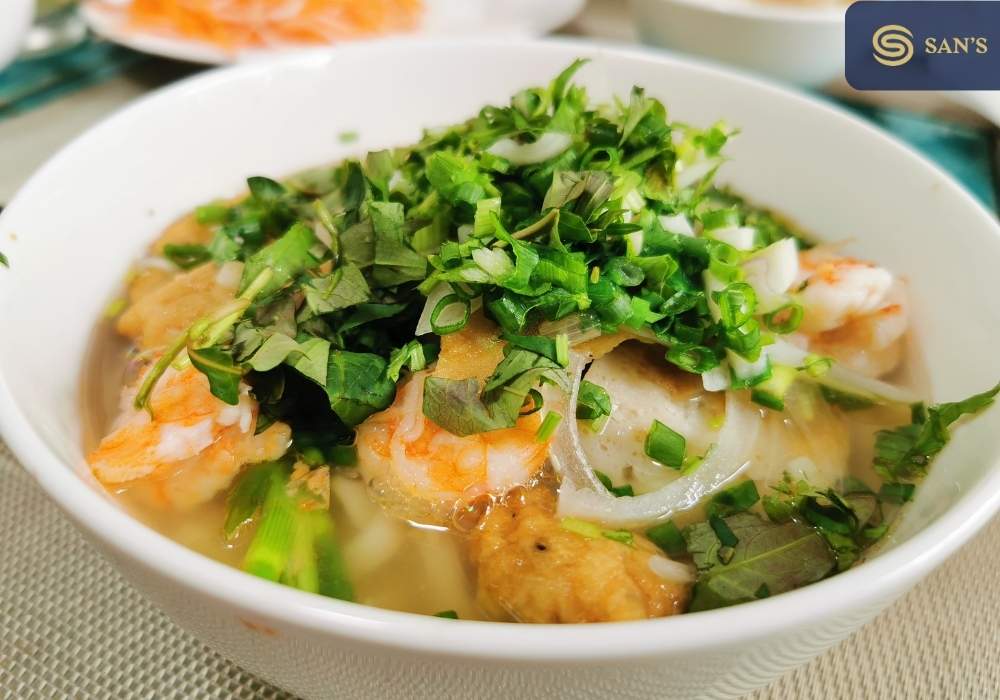
- Introduction to Bánh Canh: As one delves into the intricacies of Vietnamese cuisine, Bánh Canh stands out with its distinctively thick and chewy texture. Drawing parallels with Japan’s beloved udon, this Vietnamese noodle has carved its own identity in the vast world of Asian noodles.
- Diverse Broths and Bases: One of the hallmarks of Bánh Canh is the variety of broths it’s paired with. From the sumptuous crab and shrimp concoctions popular in coastal regions to the rich, meaty bases of pork or beef found inland, each broth tells a story of local flavors and traditions.
- Regional Variations and Toppings: Traveling through Vietnam, one would encounter diverse versions of Bánh Canh. Some regions prioritize seafood, with bowls teeming with fresh catch, while others showcase tender slices of meat or even offer vegetarian delights. These regional twists not only showcase the versatility of Bánh Canh but also highlight Vietnam’s abundant produce and culinary innovation.
- Cultural Significance and Memories: Beyond its taste and texture, Bánh Canh holds a special place in the hearts of many Vietnamese. It’s a dish that evokes memories of family gatherings, childhood meals, and festive celebrations. It’s not just a dish; it’s a tapestry of experiences, emotions, and traditions.
As we’ve traversed the intricate landscape of Vietnam’s noodle heritage, it becomes evident that each dish tells a story of its own, deeply rooted in regional traditions and flavors. From the comforting warmth of Phở to the robust taste of Bún Riêu, the country offers a noodle for every palate.
While ingredients and preparations may vary, the unifying element in all these dishes is the love and craftsmanship poured into them. The Vietnamese noodle tradition showcases a perfect blend of culture, history, and culinary artistry.
To truly appreciate the depth and diversity of this culinary gem, one must savor each noodle type firsthand. So, on your next gastronomic adventure, delve deep into the heart of Vietnam’s noodle world and discover the flavors that resonate with you.
Comment (0)